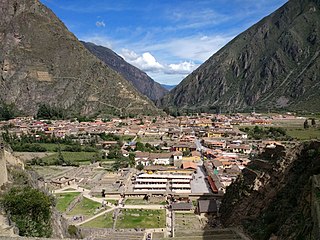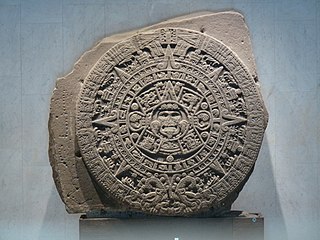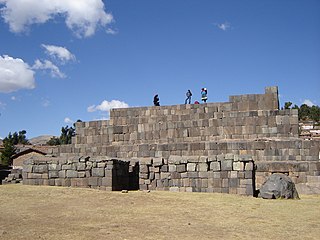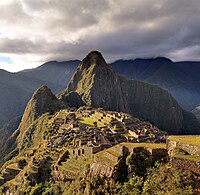
Cusco or Cuzco, is a city in Southeastern Peru near the Urubamba Valley of the Andes mountain range. It is the capital of the Cusco Region and of the Cusco Province. The city is the seventh most populous in Peru; in 2017, it had a population of 428,450. Its elevation is around 3,400 m (11,200 ft).

Pachacuti Inca Yupanqui was the ninth Sapa Inca of the Kingdom of Cusco which he transformed into the Inca Empire. Most archaeologists now believe that the famous Inca site of Machu Picchu was built as an estate for Pachacuti.

The Inca road system was the most extensive and advanced transportation system in pre-Columbian South America. It was about 40,000 kilometres (25,000 mi) long. The construction of the roads required a large expenditure of time and effort.

Sacsayhuamán, often spelled Saqsaywaman or Xacxaguaman,, is a citadel on the northern outskirts of the city of Cusco, Peru, the historic capital of the Inca Empire. The site is at an altitude of 3,701 m (12,142 ft).

Ollantaytambo is a town and an Inca archaeological site in southern Peru some 72 km (45 mi) by road northwest of the city of Cusco. It is located at an altitude of 2,792 m (9,160 ft) above sea level in the district of Ollantaytambo, province of Urubamba, Cusco region. During the Inca Empire, Ollantaytambo was the royal estate of Emperor Pachacuti, who conquered the region, and built the town and a ceremonial center. At the time of the Spanish conquest of Peru, it served as a stronghold for Manco Inca Yupanqui, leader of the Inca resistance. Located in the Sacred Valley of the Incas, it is now an important tourist attraction on account of its Inca ruins and its location en route to one of the most common starting points for the four-day, three-night hike known as the Inca Trail.

Pre-Columbian art refers to the visual arts of indigenous peoples of the Caribbean, North, Central, and South Americas from at least 13,000 BCE to the European conquests starting in the late 15th and early 16th centuries. The Pre-Columbian era continued for a time after these in many places, or had a transitional phase afterwards. Many types of perishable artifacts that were once very common, such as woven textiles, typically have not been preserved, but Precolumbian monumental sculpture, metalwork in gold, pottery, and painting on ceramics, walls, and rocks have survived more frequently.

Inca architecture is the most significant pre-Columbian architecture in South America. The Incas inherited an architectural legacy from Tiwanaku, founded in the 2nd century B.C.E. in present-day Bolivia. A core characteristic of the architectural style was to use the topography and existing materials of the land as part of the design. The capital of the Inca empire, Cuzco, still contains many fine examples of Inca architecture, although many walls of Inca masonry have been incorporated into Spanish Colonial structures. The famous royal estate of Machu Picchu is a surviving example of Inca architecture. Other significant sites include Sacsayhuamán and Ollantaytambo. The Incas also developed an extensive road system spanning most of the western length of the continent and placed their distinctive architecture along the way, thereby visually asserting their imperial rule along the frontier.

Coricancha, Koricancha, Qoricancha or Qorikancha was the most important temple in the Inca Empire. It is located in Cusco, Peru, which was the capital of the empire.

Choquequirao is an Incan site in southern Peru, similar in structure and architecture to Machu Picchu. The ruins are buildings and terraces at levels above and below Sunch'u Pata, the truncated hill top. The hilltop was anciently leveled and ringed with stones to create a 30 by 50 m platform.

A tambo was an Inca structure built for administrative and military purposes. Found along the extensive roads, tambos typically contained supplies, served as lodging for itinerant state personnel, and were depositories of quipu-based accounting records. Individuals from nearby communities within the Inca empire were conscripted to maintain and serve in the tambos, as part of the mit'a labor system. Tambos were spaced along Inca roads, generally about one day's travel apart.

Peruvian architecture is the architecture carried out during any time in what is now Peru, and by Peruvian architects worldwide. Its diversity and long history spans from ancient Peru, the Inca Empire, Colonial Peru to the present day.

The Inca army was the multi-ethnic armed forces used by the Tawantin Suyu to expand its empire and defend the sovereignty of the Sapa Inca in its territory.

Raqch'i (Quechua) is an Inca archaeological site in Peru located in the Cusco Region, Canchis Province, San Pedro District, near the populated place Raqch'i. It is 3480 meters above sea level and 110 kilometers from the city of Cuzco. It also known as the Temple of Wiracocha, one of its constituents. Both lie along the Vilcanota River. The site has experienced a recent increase in tourism in recent years, with 83,334 visitors to the site in 2006, up from 8,183 in 2000 and 452 in 1996.
The Battle of Ollantaytambo took place in January 1537, between the forces of Inca emperor Manco Inca and a Spanish expedition led by Hernando Pizarro during the Spanish conquest of Peru. A former ally of the Spaniards, Manco Inca rebelled in May 1536, and besieged a Spanish garrison in the city of Cusco. To end the stand-off, the besieged mounted a raid against the emperor's headquarters in the town of Ollantaytambo. The expedition, commanded by Hernando Pizarro, included 100 Spaniards and some 30,000 Indian auxiliaries against an Inca army more than 30,000 strong.

The Cathedral of Cusco or Cathedral Basilica of the Virgin of the Assumption is the main temple of the city of Cusco, in Peru and houses the headquarters of the Archdiocese of Cusco. The Cathedral Basilica of Cusco, together with the Triunfo temple make up the Cathedral Complex, it is located in the northeast sector of the current Plaza de Armas of Cusco. In the place that, during the Inca period, was occupied by both the Suntor Wassi and the Kisoarkancha or Palace of the eighth Inca Viracocha. The complex occupies an area of 3,920 square meters and is the most important religious monument in the Historic Center of Cusco.

An ushnu or usnu is a pyramid-shaped, terraced structure that was used by the Inca to preside at the most important ceremonies of the Tawantinsuyu, or Inca Empire.

Tipón, is a sprawling early fifteenth-century Inca archaeological park that is situated between 3,250 metres (10,660 ft) and 3,960 metres (12,990 ft) above sea level, located 22 kilometres (14 mi) southeast of Cusco near the village of Tipón. It consists of several ruins enclosed by a powerful defensive wall about 6 kilometres (3.7 mi) long. The most renown part of the park is the group of precise and right angled monumental terraces irrigated by a network of water canals fed by a monumental fountain channeling water from a natural spring. The site includes ancient residential areas and a remarkable amount of petroglyphs in its upper part.
Tampukancha is an ancient Incan religious center located in Peru. It is located in the Cusco Region, Anta Province, Zurite District, about 30 miles from Cusco, the historic capital of the Inca Empire.
Diego González Holguín was a Spanish Jesuit priest and missionary, as well as a scholar of the Quechua languages during the era of the Viceroyalty of Peru.

Muyuq Marka, also Muyuqmarka, is an archaeological site in Peru. It is the base of what was a round Incan tower, which is situated within the fortress Saksaywaman above Cuzco. It was used as a Temple of Inti, but became part of a complex of rectangular buildings which mostly still remain today. However, the temple and the two flanking towers were dismantled during the Spanish rule. What remains of Muyuq Marka indicates that it was "a round building with an open central court which had a fountain." The temple had triple walls, which were aligned with the zenith sunrise and the antizenith sunset.























